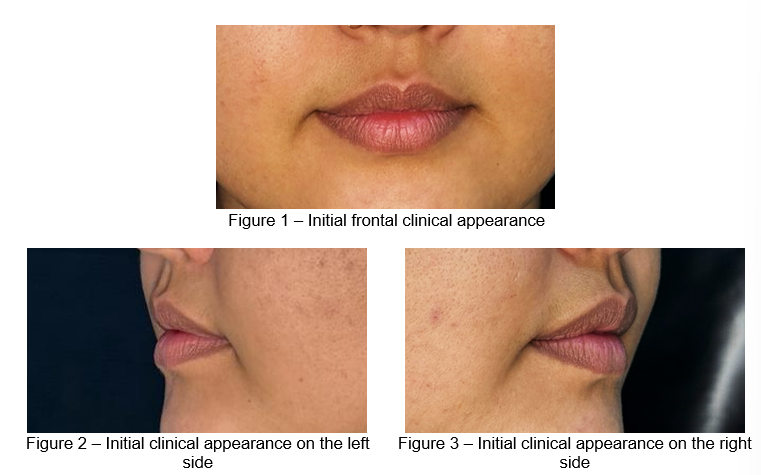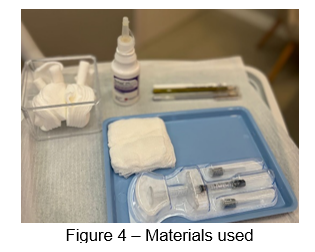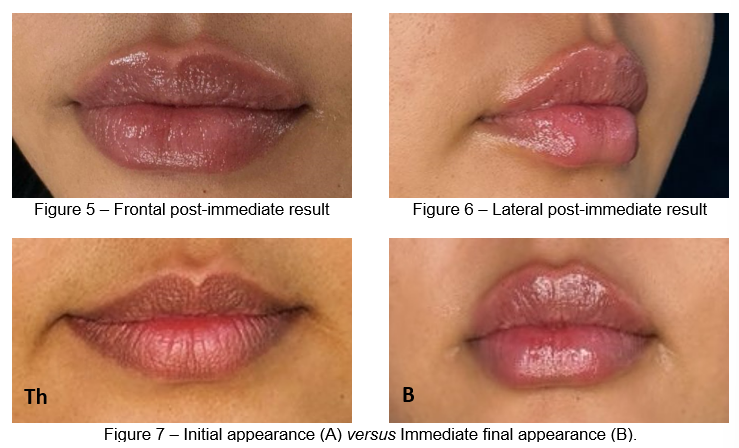O USO DO ÁCIDO HIALURÔNICO EM PREENCHIMENTO LABIAL: RELATO DE CASO
EL USO DEL ÁCIDO HIALURÓNICO EN LOS RELLENOS LABIALES: RELATO DE UN CASO
REGISTRO DOI: 10.69849/revistaft/th10249091348
Letícia Fabiana Sampaio Quaresma1
Marivone Batista Ribeiro Polesso2
ABSTRACT
In recent decades, the search for aesthetic procedures has grown, reflecting the growing desire for improvements in physical appearance and self-esteem. Orofacial harmonization stands out in this context for offering minimally invasive techniques, such as lip fillers with hyaluronic acid, which provide quick and effective results. The objective of this study is to report a clinical case of lip fillers with hyaluronic acid, detailing the diagnosis, the technique used and the results obtained. Patient S.O.G., 20 years old, came to the Orofacial Harmonization clinic of the Faculty of Amazonas complaining of thin lips and poorly defined contours. After a clinical evaluation and detailed anamnesis, a treatment plan was developed that included the use of 1 mL of Hyaluronic Acid (RENNOVA LIFT).® The procedure resulted in a satisfactory increase in lip volume and definition of contours, meeting the patient’s expectations. It is concluded that lip fillers with hyaluronic acid are an effective and safe technique, providing natural and satisfactory aesthetic results, confirming its feasibility and benefits in the context of orofacial harmonization.
Keywords: Orofacial harmonization. Lip filler. Hyaluronic acid. Aesthetic procedures.
RESUMO
Nas últimas décadas, a busca por procedimentos estéticos tem crescido, refletindo o desejo crescente por melhorias na aparência física e autoestima. A harmonização orofacial destaca-se nesse contexto por oferecer técnicas minimamente invasivas, como o preenchimento labial com ácido hialurônico, que proporcionam resultados rápidos e eficazes. O objetivo deste trabalho é relatar um caso clínico de preenchimento labial com ácido hialurônico, detalhando o diagnóstico, a técnica utilizada e os resultados obtidos. Paciente S.O.G., 20 anos, procurou a clínica de Harmonização Orofacial da Faculdade do Amazonas com a queixa de lábios finos e contornos pouco definidos. Após uma avaliação clínica e anamnese detalhada, foi elaborado um plano de tratamento que incluiu o uso de 1 mL de ácido hialurônico (RENNOVA LIFT®). O procedimento resultou em um aumento satisfatório do volume labial e definição dos contornos, atendendo às expectativas da paciente. Conclui-se que o preenchimento labial com ácido hialurônico é uma técnica eficaz e segura, proporcionando resultados estéticos naturais e satisfatórios, confirmando sua viabilidade e benefícios no contexto da harmonização orofacial.
Palavras-chave: Harmonização orofacial. Preenchimento labial. Ácido hialurônico. Procedimentos estéticos.
1 INTRODUCTION
In recent decades, the search for aesthetic procedures has intensified significantly, reflecting people’s growing desire to improve their physical appearance and, consequently, their self-esteem. People’s appearance is significantly related to psychological well-being and social life. Given this, this search for aesthetic perfection is not limited to invasive plastic surgeries, but also includes minimally invasive procedures that provide quick and effective results (1,2).
Within this context, orofacial harmonization has gained prominence as a multidisciplinary area that encompasses various techniques to improve facial aesthetics and orofacial functionality. Orofacial harmonization involves procedures such as the application of botulinum toxin, collagen biostimulators, support threads and facial fillers, with the aim of providing a harmonious balance between the different structures of the face. Due to their less invasive nature and shorter recovery time compared to traditional surgeries, these procedures are increasingly in demand (3,4).
Lip fillers with hyaluronic acid are a popular and effective treatment for orofacial harmonization. This, in turn, aims to increase the volume and redefine the contour of the lips, using substances such as hyaluronic acid, which is a natural component of the skin’s extracellular matrix. The popularity of lip fillers can be attributed to its ability to provide immediate and natural results, as well as its reversibility, since hyaluronic acid can be degraded by specific enzymes if necessary (5,6).
The effectiveness of hyaluronic acid as a lip filler material has been widely documented in the scientific literature. The application of hyaluronic acid on the lips not only improves the aesthetic appearance but also contributes to the hydration and elasticity of the local skin. In addition, studies indicate that lip fillers with hyaluronic acid have a favorable safety profile, with low complication rates when performed by qualified professionals (7,8).
Despite the benefits, it is crucial that lip fillers are performed with a personalized approach, taking into account the individual characteristics of each patient. Detailed prior evaluation and proper planning are essential to achieve satisfactory aesthetic results and avoid complications. In addition, the choice of the type and concentration of hyaluronic acid should be made based on the specific needs of each case, aiming for a natural and harmonious result (9,10).
In addition to aesthetics, lip fillers can also have functional benefits. The application of hyaluronic acid to the lips can help correct asymmetries, improve lip contour definition, and even assist in the rehabilitation of patients with orofacial problems resulting from trauma or congenital conditions (11,12).
Another important aspect to consider is the longevity of the results. Although hyaluronic acid is naturally degraded by the body over time, the effects of lip fillers can last anywhere from 6 to 12 months, depending on factors such as the patient’s metabolism and the technique used. The durability, coupled with the safety of the procedure, makes lip fillers an attractive choice for those who want to improve the appearance of their lips without compromising their naturalness (7,13).
Thus, the objective of this study is to report a clinical case of lip fillers with hyaluronic acid, detailing the diagnosis, the technique used and the results obtained, highlighting the indications and benefits of this procedure in the context of orofacial harmonization.
2 CASE REPORT
Patient S.O.G., 20 years old, came to the Orofacial Harmonization Specialization Clinic (HOF) of the Faculty of Amazonas (IAES) with the complaint of wanting to increase the lip volume to obtain a more defined and attractive contour. During the anamnesis, it was found that the patient did not present relevant systemic alterations, being healthy and without a history of allergies or other medical conditions that could contraindicate the procedure.
After anamnesis and clinical evaluation, it was observed that the patient had thin lips, with little definition of contour, which motivated her to seek aesthetic treatment (Figures 1, 2 and 3). The patient demonstrated realistic expectations regarding the expected results and was duly informed about the procedure, possible risks, and postoperative care.

A treatment plan was developed that consisted of lip fillers using a 1 mL syringe of hyaluronic acid (RENNOVA LIFT®) of medium cross-linking, a high-quality product known to provide natural and long-lasting results (Figure 3).

As a way to start the aesthetic procedure, rigorous antisepsis of the perioral region was performed with 2% chlorhexidine (Riohex®), to ensure a contamination-free environment. With the patient seated in the chair at a 45º angle, the labiogram was demarcated and then anesthesia was performed using 2% lidocaine anesthetic solution with epinephrine 1:100,000 to minimize discomfort during the procedure.
The procedure was initiated by the lower lip, where two 0.05 mL retroinjections of the product were made in the contour of the lower lip, one on the right side and one on the left lower contour. After that, a bolus of 0.2 mL was injected into the vermilion region of the right lip and another 0.15 mL into the vermilion of the left lip. Next, filling of the upper lip was initiated through the lip filter with a backinjection of 0.1 mL of the product on each side. Cupid’s bow was filled with 0.025 mL of product on the right side and 0.025 mL on the left side.
Continuation of the procedure involved two retroinjections into the contour of the upper lip, one with 0.05 mL on the left side and the other with 0.1 mL on the right side. Two beams were made in the vertical direction coming out of the highest point of the cupid’s bow, each with 0.05 mL of product, both on the right and left sides. Throughout the procedure, the patient was monitored for comfort and possible adverse reactions, and there were no complications.
Post-procedure recommendations included applying ice for the first few hours to minimize swelling, avoiding manipulating the application site, not exposing yourself to the sun or excessive heat, and not wearing makeup for the first 24 hours. In addition, it was advised to avoid heavy physical or sports activities in the first three days.
The patient’s images were captured for evaluation of the results (Figures 5, 6 and 7 A-B). Leaving satisfied with the immediate results, presenting more voluminous and well-defined lips, according to your expectations and what was planned in the treatment.

3 DISCUSSION
This study addressed orofacial harmonization by means of lip fillers using hyaluronic acid (Rennova Lift®) in a young, healthy patient with aesthetic complaints of thin lips. The results showed that the procedure achieved a significant increase in lip volume and a more attractive definition of lip contours, meeting the patient’s expectations.
The findings of this study indicate that lip fillers with hyaluronic acid are an effective technique to improve lip aesthetics, resulting in increased volume and contour definition. The use of 1 mL of Rennova Lift® proved to be adequate to obtain natural and harmonic results. The patient’s satisfaction with the results reinforces the effectiveness of the procedure and the importance of the appropriate selection of the product and the application technique.
The results of this study are in accordance with the existing literature. Valente et al. (7) stated that hyaluronic acid is an effective and safe dermal filler for improving the volume and appearance of the lips. Byrro et al. (14) They also highlighted that lip fillers with hyaluronic acid are safe and effective procedures, providing high patient satisfaction.
Scarano et al. (15) and Czumbel et al. (8) corroborate these findings, showing that cross-linked hyaluronic acid is a safe and effective material for lip augmentation, with significant improvements in the volume and overall appearance of the lips. Taylor et al. (2019) added that in individuals with black skin, hyaluronic acid fillers are also effective, demonstrating improvement in lip fullness and reduction of perioral lines.
Stojanovič et al. (16) and Pinheiro et al. (17) reinforce that fillers with hyaluronic acid are effective and safe to increase the overall volume of the lips, which is relevant for clinical application. Friedman et al. (18) highlighted the low incidence of adverse events associated with the use of non-animal stabilized hyaluronic acid gel for soft tissue augmentation, indicating high biocompatibility of the material.
Hyaluronic acid, a natural component of the skin, provides hydration and volume, which explains the results observed. The back-injection technique and the use of small amounts at specific points allowed for an even distribution of the product, avoiding irregularities and providing a more defined and attractive lip contour. Rho et al. (19) highlight that fillers with intermediate reticulation density, such as the one used in this study, are particularly effective for increasing lip volume.
Among the strengths of this study, the use of a well-established technique and the choice of a quality product stand out, which together contributed to the positive results observed. However, the main limitation is the sample size, which is restricted to a single patient, which limits the generalizability of the results. Future studies with larger samples are needed to confirm these findings.
The findings of this study have significant practical implications for the clinical practice of orofacial harmonization. Hyaluronic acid lip fillers can be an effective option for patients seeking aesthetic lip improvements without resorting to invasive procedures. Czumbel et al. (8) They reinforce that, although hyaluronic acid is effective, professionals must be aware of the possible adverse effects, such as sensitivity, swelling and bruising, and be prepared to manage them appropriately.
Colon et al. (20) emphasized the need to monitor adverse events such as swelling, lumps, and firmness, especially in facial regions such as the lips. Proper management of these effects is crucial to ensure patient safety and satisfaction. In the case presented here, the patient did not present adverse effects such as those reported in the existing literature.
Future research should explore larger and diversified samples to validate the results found. Additionally, comparative studies between different types of hyaluronic acid and application techniques can provide valuable insights to optimize lip filler results. Demosthenous et al. (21) suggest that the efficacy and tolerability of dermal fillers should be evaluated over time, which may be a focus for subsequent research.
Therefore, lip filler with Hyaluronic Acid (Rennova Lift®) has been shown to be an effective and safe technique for aesthetic enhancement of the lips. This study contributes to the existing literature by confirming the efficacy of the procedure and reinforcing the importance of appropriate technique and product choice. The positive results obtained and the patient’s satisfaction highlight the potential of this treatment in clinical practice.
Aesthetic procedures, when performed ethically and responsibly, can improve the self-esteem and psychological well-being of patients. It is crucial for providers to properly inform patients about the risks and benefits, ensuring informed consent and realistic expectations. Signorini et al. (22) underline the importance of preventing and properly treating complications from hyaluronic acid fillers, ensuring patient safety.
4 CONCLUSION
It is concluded that lip filler with Hyaluronic Acid (Rennova Lift®) is an effective and safe technique to increase the volume and define the contours of the lips, meeting the aesthetic expectations of the young and healthy patient studied. The positive results observed corroborate the existing literature and indicate that this approach is a viable option for the aesthetic improvement of the lips.
REFERENCES
1. Alexandrova-Karamanova A. Appearance self-attitudes and health and well-being of Bulgarian adolescents. Cent Eur J Paediatr. 2020;16(1):69–82.
2. Woodspring N. Aging appearance and its significance to well-being. Vol. 3, Innovation in Aging. 2019. p. S605.
3. Costa AMC, Nogueira R da S, Lemos AC de A, Santos BN dos, Silva LS de A, Costa LLL da, et al. Harmonização orofacial frente ao uso da toxina botulínica. Brazilian J Heal Rev. 2021;4(3):12864–12872.
4. Medeiros Júnior JC, Suguihara RT, Muknicka DP. Bioestimuladores de colágeno na harmonização orofacial. Res Soc Dev. 2023;12(7):e19912742716.
5. Cavallini M, Pierce A, Nakab L. Comparative in vivo degradation of hyaluronic acid-based fillers following injection of hyaluronidase. Vol. 23, Journal of cosmetic dermatology. England; 2024. p. 356–7.
6. Dantas A, Bezerra R, Nojima C, Lira K, Silva G, Oliveira J, et al. Lip rejuvenation with hyaluronic acid: case report. Heal Soc. 2022;2(2):164–74.
7. Souto Valente D, Bins Ely P, Koehler Zanella R, Marques Jardim G, Guimarães Herzog C, Gianesini G, et al. Lips enhancement using hyaluronic acid. J Dermatology Cosmetol. 2023;7(2):46–8.
8. Czumbel LM, Farkasdi S, Gede N, Mikó A, Csupor D, Lukács A, et al. Hyaluronic acid is an effective dermal filler for lip augmentation: a meta-analysis. Front Surg. 2021 Aug 6;8:1–16.
9. Corduff N, Juniarti L, Lim TS, Lin F, Mariwalla K, Pavicic T, et al. Current Practices in Hyaluronic Acid Dermal Filler Treatment in Asia Pacific and Practical Approaches to Achieving Safe and Natural-Looking Results. Clin Cosmet Investig Dermatol. 2022;15:1213–23.
10. Zazzaron M. Customized lip enhancement for clinical different lip features: An observational study. J Cosmet Dermatol. 2020 Jan;19(1):38–46.
11. Santos IC, Gomes Da Silva R, Leite G, Martins De Oliveira C, Mônica ;, Pereira R, et al. Hyaluronic Acid Dermal Fillers for Treatment of Congenital and Acquired Lip Asymmetries and Deformities Rellenos Dérmicos de Ácido Hialurónico para el Tratamiento de Asimetrías y Deformidades Labiales Congénitas y Adquiridas. Int J Odontostomat. 2023;17(4):392–9.
12. Wollina U, Goldman A. Lip enhancement and mouth corner lift with fillers and botulinum toxin A. Dermatol Ther. 2020;33(6):1–6.
13. Xie Y, Wu S, Li S, Li Q, Zhao H. Evaluation of the long-term safety and biodegradability of hyaluronic acid dermal fillers (YVOIRE(®) ) for the correction of nasolabial folds: Two multicenter, prospective, observational cohort studies. J Cosmet Dermatol. 2022 Jun;21(6):2387–97.
14. Byrro D, Garcia ASN. Lip Filler with hyaluronic acid: case report. Heal Soc. 2022 Dec 21;2(04 SE-Health Studies):173–96.
15. Scarano A, Puglia F, Cassese R, Mordente I, Amore R, Ferraro G, et al. Hyaluronic acid fillers in lip augmentation procedure: a clinical and histological study. J Biol Regul Homeost Agents. 2019;33(6 Suppl. 2):103-108. DENTAL SUPPLEMENT.
16. Stojanovič L, Majdič N. Effectiveness and safety of hyaluronic acid fillers used to enhance overall lip fullness: a systematic review of clinical studies. J Cosmet Dermatol. 2019;18(2):436–43.
17. Pinheiro MVB, Bagatin E, Hassun KM, Talarico S. Adverse effect of soft tissue augmentation with hyaluronic acid. J Cosmet Dermatol. 2005 Sep;4(3):184–6.
18. Friedman PM, Mafong EA, Kauvar ANB, Geronemus RG. Safety data of injectable nonanimal stabilized hyaluronic acid gel for soft tissue augmentation. Dermatologic Surg Off Publ Am Soc Dermatologic Surg [et al]. 2002 Jun;28(6):491–4.
19. Rho N-K, Goo BL, Youn S-J, Won C-H, Han K-H. Lip Lifting Efficacy of Hyaluronic Acid Filler Injections: A Quantitative Assessment Using 3-Dimensional Photography. J Clin Med. 2022 Aug;11(15).
20. Colon J, Mirkin S, Hardigan P, Elias MJ, Jacobs RJ. Adverse events reported from hyaluronic acid dermal filler injections to the facial region: a systematic review and meta-analysis. Cureus. 2023;15(4).
21. Demosthenous N, Eccleston D, Figueiredo V, Uva L, Kerson G, Silberberg M. A Prospective, Open-Label, Multicenter, Real-World Study of VYC-17.5L Hyaluronic Acid Dermal Filler in the Lips. Aesthetic Surg journal Open forum. 2022;4:ojac047.
22. Signorini M, Liew S, Sundaram H, De Boulle KL, Goodman GJ, Monheit G, et al. Global Aesthetics Consensus: Avoidance and Management of Complications from Hyaluronic Acid Fillers-Evidence- and Opinion-Based Review and Consensus Recommendations. Plast Reconstr Surg. 2016 Jun 1;137(6):961e-971e.
1 Specialist in Orofacial Harmonization
Institution: Faculdade do Amazonas – IAES (Manaus, AM)
2 Specialist in Orofacial Harmonization
Institution: Faculdade do Amazonas – IAES (Manaus, AM)
